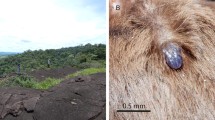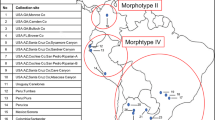Abstract
Evidence suggesting polyphyly of the traditionally recognised tick genus Aponomma Neumann, 1899 is summarized. Continued recognition of this genus in its current concept leaves a polyphyletic genus Aponomma and a paraphyletic genus Amblyomma Koch, 1844. To improve the correlation between our understanding of phylogenetic relationships in metastriate ticks and their classification, a few changes in classification are proposed. The members of the `indigenous Australian Aponomma' group (sensu Kaufman, 1972), A. auruginans Schulze, 1936, A. concolor Neumann, 1899, A. glebopalma Keirans, King & Sharrad, 1994, A. hydrosauri (Denny, 1843) and A. undatum (Fabricius, 1775), are transferred to Bothriocroton Keirans, King & Sharrad, 1994, which is raised to full generic rank. The remaining members of Aponomma are transferred to Amblyomma. Uncertainty remains on relationships of Bothriocroton to other metastriate lineages and on the systematic position of the two species formerly included in the `primitive Aponomma' group, A. elaphense Price, 1959 and A. sphenodonti Dumbleton, 1943.
Similar content being viewed by others
References
Binnington, K.C. (1972) The distribution and morphology of probable photoreceptors in eight species of ticks (Ixodoidea). Zeitschrift für Parasitenkunde, 40, 321-332.
Borges, L.M.F., Labruna, M.B., Linardi, P.M. & Ribeiro, M.F.B. (1998) Recognition of the tick genus Anocentor Schulze, 1937 (Acari: Ixodidae) by numerical taxonomy. Journal of Medical Entomology, 35, 891-894.
Camicas, J.L. & Morel, P.C. (1977) Position systematique et classification des tiques (Acarida: Ixodida). Acarologia, 18, 410-420.
Clifford, C.M., Anastos, G. & Elbl, A. (1961) The larval ixodid ticks of the Eastern United States (Acarina: Ixodidae). Miscellaneous Publications of the Entomological Society of America, 2, 213-237.
Crosbie, P.R., Boyce, W.M. & Rodwell, T.C. (1998) DNA sequence variation in Dermacentor hunteri and estimated phylogenies of Dermacentor spp. (Acari: Ixodidae) in the New World. Journal of Medical Entomology, 35, 277-288.
Dias, J.A.T.S. (1993) Contribuiçao para o estudo da sistemática e taxonomia das espécies do género Aponomma Neumann, 1899 (Acarina-Ixodoidea). Ministério do Planeamento e da Administraçao do Território, Instituto de Investigaçao Científica Tropical, Estudos, Ensaios e Documentos, Lisboa, 157, 14-205.
Dobson, S.J. & Barker, S.C. (1999) Phylogeny of the hard ticks (Ixodidae) inferred from 18S RNA indicates the genus Aponomma is paraphyletic. Molecular Phylogenetics and Evolution, 11, 288-295.
Dumbleton, L.J. (1943) A new tick from the tuatara (Sphenodon punctatus). New Zealand Journal of Science and Technology, 24, 185-190.
Filippova, N.A. (1997) Ixodid ticks of subfamily Amblyomminae.St. Petersburg: Nauka Publishing House, 446 pp. (In Russian).
Hoogstraal, H. & Aeschlimann, A. (1982) Tick-host specificity. Bulletin de la Société Entomologique Suisse, 55, 5-32.
Kaufman, T.S. (1972) A revision of the genus Aponomma Neumann, 1899 (Acarina: Ixodidae). PhD dissertation, University of Maryland, 389 pp.
Keirans, J.E. (1992) Systematics of the Ixodida (Argasidae, Ixodidae, Nuttalliellidae): an overview and some problems. In: Fivaz, B.H., Petney, T.N. & Horak, I.G. (Eds) Tick vector biology. Medical and veterinary aspects. Berlin: Springer-Verlag, pp. 1-21.
Keirans, J.E., King, D.R. & Sharrad, R.D. (1994) Aponomma (Bothriocroton) glebopalma, n. subgen., n. sp., and Amblyomma glauerti n. sp. (Acari: Ixodida: Ixodidae), parasites of monitor lizards (Varanidae) in Australia. Journal of Medical Entomology, 31, 132-147.
Keirans, J.E. & Klompen, J.S.H. (1996) Amblyomma quadricavum (Schulze) (new combination), and Amblyomma arianae Keirans & Garris, a new junior synonym of Amblyomma quadricavum (Acari: Ixodidae). Proceedings of the Entomological Society of Washington, 98, 164-165.
Keirans, J.E. & Robbins, R.G. (1999) A world checklist of genera, subgenera, and species of ticks (Acari: Ixodida) published from 1973-1997. Journal of Vector Ecology, 24, 115-129.
Klompen, J.S.H., Black, W.C., IV, Keirans, J.E. & Norris, D.E. (2000) Systematics and biogeography of hard ticks, a total evidence approach. Cladistics, 16, 79-102.
Klompen, J.S.H., Keirans, J.E., Filippova, N.A. & Oliver, J.H., Jr (1996) Idiosomal lyrifissures, setae, and small glands as taxonomic characters and potential indicators of ancestral segmentation patterns in larval Ixodidae (Acari: Ixodida). International Journal of Acarology, 22, 113-134.
Klompen, J.S.H. & Oliver, J.H., Jr (1993) Systematic relationships in the soft ticks (Acari: Ixodida: Argasidae). Systematic Entomology, 18, 313-331.
Klompen, J.S.H., Oliver, J.H., Jr, Keirans, J.E. & Homsher, P.J. (1997) A reevaluation of relationships in the Metastriata (Acari: Parasitiformes: Ixodida). Systematic Parasitology, 38, 1-24.
Lehtinen, P.T. (1991) Phylogeny and zoogeography of the Holothyrida. In: Dusbábek, F. & Bukva, V. (Eds) Modern Acarology, Volume II. The Hague: SPB Academic, pp. 101-113.
Murrell, A., Campbell, N.J.H. & Barker, S.C. (2001) A total-evidence phylogeny of ticks provides insights into the evolution of life cycles and biogeography. Molecular Phylogenetics and Evolution, 21, 244-258.
Neumann, L.G. (1899) Révision de la famille des ixodidés. (3e mémoire). Mémoirs du Societé de Zoologie de France, 12, 107-294.
Nuttall, G.H.F. & Warburton, C. (1911) Ticks: a monograph of the Ixodoidea, Part II: The genus Ixodes. Cambridge: Cambridge University Press, 105-348 pp.
Oliver, J.H., Jr (1977) Cytogenetics of mites and ticks. Annual Review of Entomology, 22, 407-429.
Roberts, F.H.S. (1970) Australian ticks. Yeerongpilly, Queensland: CSIRO, 267 pp.
Author information
Authors and Affiliations
Rights and permissions
About this article
Cite this article
Klompen, H., Dobson, S.J. & Barker, S.C. A new subfamily, Bothriocrotoninae n. subfam., for the genus Bothriocroton Keirans, King & Sharrad, 1994 status amend. (Ixodida: Ixodidae), and the synonymy of Aponomma Neumann, 1899 with Amblyomma Koch, 1844. Syst Parasitol 53, 101–107 (2002). https://doi.org/10.1023/A:1020466007722
Issue Date:
DOI: https://doi.org/10.1023/A:1020466007722




